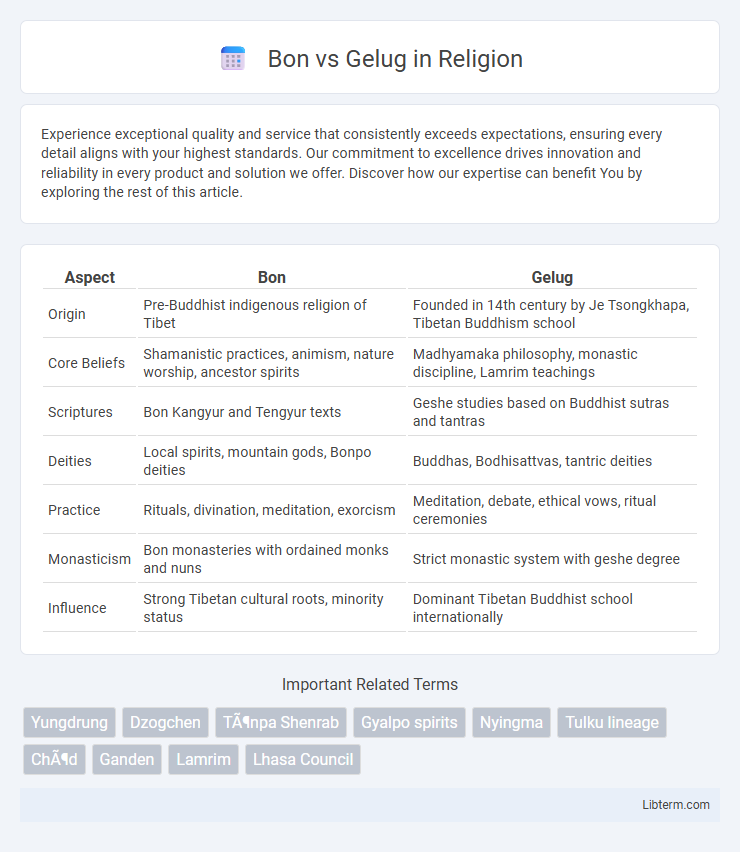Experience exceptional quality and service that consistently exceeds expectations, ensuring every detail aligns with your highest standards. Our commitment to excellence drives innovation and reliability in every product and solution we offer. Discover how our expertise can benefit You by exploring the rest of this article.
Table of Comparison
| Aspect | Bon | Gelug |
|---|---|---|
| Origin | Pre-Buddhist indigenous religion of Tibet | Founded in 14th century by Je Tsongkhapa, Tibetan Buddhism school |
| Core Beliefs | Shamanistic practices, animism, nature worship, ancestor spirits | Madhyamaka philosophy, monastic discipline, Lamrim teachings |
| Scriptures | Bon Kangyur and Tengyur texts | Geshe studies based on Buddhist sutras and tantras |
| Deities | Local spirits, mountain gods, Bonpo deities | Buddhas, Bodhisattvas, tantric deities |
| Practice | Rituals, divination, meditation, exorcism | Meditation, debate, ethical vows, ritual ceremonies |
| Monasticism | Bon monasteries with ordained monks and nuns | Strict monastic system with geshe degree |
| Influence | Strong Tibetan cultural roots, minority status | Dominant Tibetan Buddhist school internationally |
Origins of Bon and Gelug Traditions
The Bon tradition, considered Tibet's oldest spiritual practice, originates from pre-Buddhist shamanistic and animistic rituals dating back over 3,000 years. In contrast, the Gelug tradition was founded in the 14th century by Je Tsongkhapa, emphasizing strict monastic discipline and scholastic study within Tibetan Buddhism. These distinct origins highlight Bon's indigenous roots and Gelug's reformative adaptation of Buddhist teachings.
Core Philosophical Differences
Bon tradition emphasizes shamanistic and animistic elements infused with Tibetan spirituality, focusing on ritual practices and the reverence of nature spirits. Gelug school, founded by Je Tsongkhapa in the 14th century, prioritizes rigorous scholastic study, monastic discipline, and the Madhyamaka philosophy of emptiness. Core philosophical differences center on Bon's incorporation of pre-Buddhist Tibetan beliefs and Gelug's strict adherence to Buddhist sutras and commentaries emphasizing logic and debate.
Major Deities and Symbolism
Bon features major deities such as Tonpa Shenrab, revered as the founder, along with the protector spirits known as the Five Warrior Deities, symbolizing power and protection. Gelug, the newest school of Tibetan Buddhism, emphasizes figures like Je Tsongkhapa, its founder, and the Buddha Shakyamuni, with symbolism centered on wisdom and monastic discipline. Both traditions utilize mandalas and intricate iconography, but Bon's symbols often include the swastika and the nine vajras, reflecting its shamanistic and pre-Buddhist roots, while Gelug symbols focus on the dharma wheel and lotus, representing Buddhist teachings and purity.
Founders and Key Historical Figures
Bon, an ancient Tibetan spiritual tradition, was founded by Tonpa Shenrab, revered as the original teacher who transmitted its esoteric teachings, while notable figures like Shenchen Luga played a crucial role in preserving Bon scriptures. The Gelug school, established in the 14th century by Je Tsongkhapa, emphasized monastic discipline and scholasticism, with prominent leaders such as the Dalai Lamas shaping its philosophical and political influence. Both traditions highlight the profound impact of their founders and key historical figures in shaping Tibetan religious identity and practice.
Ritual Practices and Ceremonies
Bon rituals emphasize shamanic practices, including spirit possession, exorcisms, and offerings to a pantheon of deities rooted in ancient Tibetan animism. Gelug ceremonies focus on monastic discipline with elaborate meditation sessions, tantric rituals, and the chanting of sutras led by ordained lamas. Both traditions employ intricate rituals, but Bon integrates indigenous elements, while Gelug aligns closely with the structured practices established by Tsongkhapa in Tibetan Buddhism.
Sacred Texts and Canonical Literature
The Bon tradition's sacred texts primarily encompass the Kangding and the Nine Ways of Bon, emphasizing ancient Tibetan oral scriptures and ritual manuals, distinct from Buddhist canons. The Gelug school relies on the Tibetan Buddhist Kangyur and Tengyur collections, containing the Buddha's teachings and extensive commentaries by esteemed scholars like Tsongkhapa. While Bon scriptures focus on indigenous Tibetan cosmology and shamanistic practices, the Gelug canonical literature centers on Mahayana philosophy, logic, and monastic discipline.
Monastic Structure and Organization
Bon and Gelug traditions exhibit distinct monastic structures and organizational hierarchies. Bon monasteries blend indigenous Tibetan ritual leadership with structured monastic communities, often emphasizing shamanistic practices alongside scriptural study. In contrast, Gelug monasticism, founded by Je Tsongkhapa, features a highly centralized system focused on scholarly discipline, formal debate, and strict adherence to the Vinaya code, with the Dalai Lama traditionally serving as the spiritual leader.
Influence on Tibetan Culture and Society
Bon, as the indigenous spiritual tradition of Tibet, profoundly shaped Tibetan culture with its animistic rituals, shamanistic practices, and reverence for nature, deeply influencing local customs, art, and social norms. Gelug, founded by Je Tsongkhapa in the 14th century, introduced a rigorous monastic system, scholasticism, and ethical discipline, establishing central authority through the Dalai Lama institution that redefined Tibetan political and religious structures. The coexistence and interplay of Bon and Gelug traditions enriched Tibetan identity, blending indigenous beliefs with Buddhist philosophy to create a unique cultural and spiritual tapestry.
Contemporary Developments and Challenges
Contemporary developments in the Bon and Gelug traditions highlight ongoing efforts to preserve unique spiritual practices amidst globalization and modernization pressures. The Bon community actively revitalizes its shamanistic rituals and scriptural studies to assert its identity alongside the more institutionalized Gelug school, which continues to emphasize scholasticism and monastic discipline. Both face challenges from political dynamics in Tibet and the diaspora, affecting propagation and cultural preservation.
Comparative Legacy and Global Impact
The Gelug school, founded by Je Tsongkhapa in the 14th century, has significantly shaped Tibetan Buddhism through its emphasis on monastic discipline and scholastic rigor, producing influential figures like the Dalai Lama. Bon, often regarded as Tibet's indigenous spiritual tradition predating Buddhism, preserves ancient shamanistic and ritual practices that continue to influence Tibetan culture and identity. Both traditions contribute uniquely to Tibetan religious heritage, with Gelug exerting widespread institutional and political influence globally, while Bon sustains a vital cultural legacy and enriches the diversity of Tibetan spiritual history.
Bon Infographic

 libterm.com
libterm.com